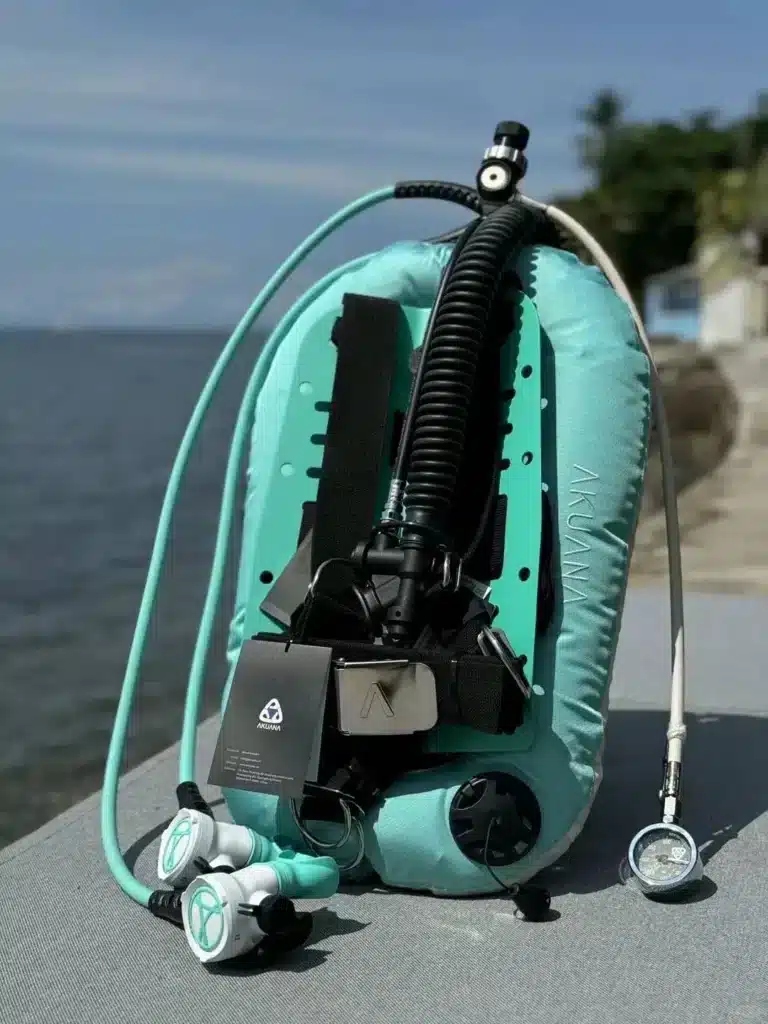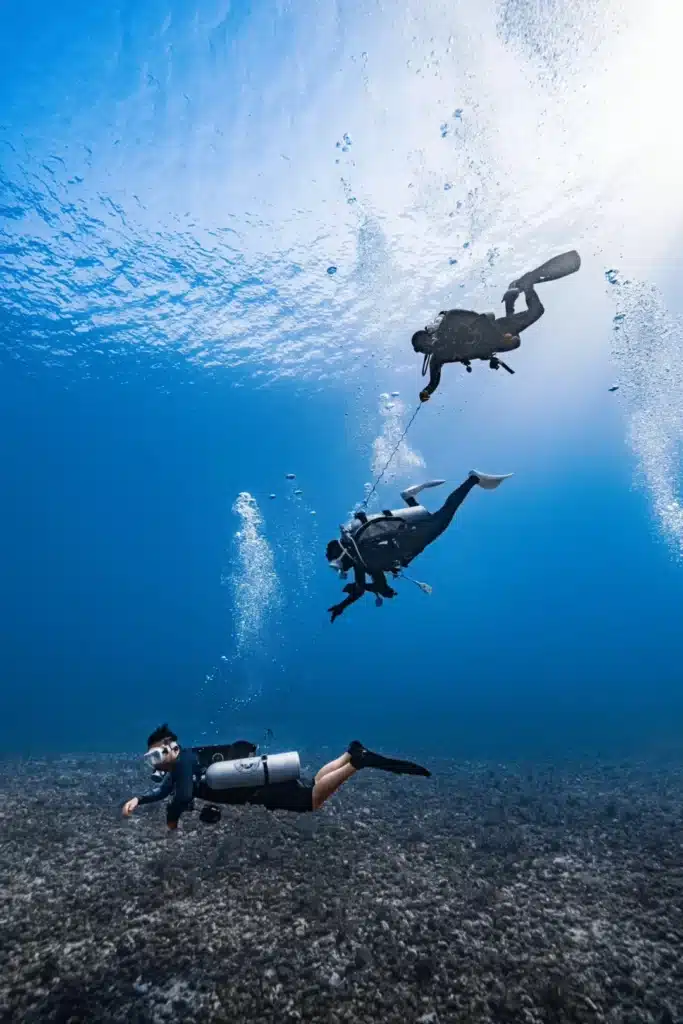Diving is a fascinating and challenging sport that allows us to get up close and personal with vibrant marine life and breathtaking underwater landscapes. However, like any adventurous activity, it comes with a certain amount of risk and potential emergencies. Being prepared for underwater surprises can mean the difference between a minor inconvenience and a life-threatening event. In this article, we’ll explore common scuba diving emergencies and provide actionable steps to effectively manage them.
Running Out of Air
Description:
Air depletion underwater can arise unexpectedly and jeopardize your safety.
Common Causes:
- Equipment Malfunction: Faulty regulators or leaks in the cylinder can cause rapid air loss.
- Overexertion: Excessive physical effort leads to rapid, shallow breathing.
- Poor Dive Planning: Inadequate assessment of dive depth, duration, or air supply relative to your experience and physical ability.
Solution:
- Stay Calm: Control your breathing to conserve air.
- Initiate a Controlled Ascent: Ascend slowly (no more than 18 meters or 60 feet per minute) while breathing continuously.
- Communicate: Use standard hand signals to notify your dive buddy of your low air supply.
- Seek Assistance: Request spare air from your buddy or nearby divers.
Prevention:
- Conduct thorough pre-dive equipment checks.
- Plan dives realistically based on your physical condition, experience, and available air.
- Continuously monitor your air supply throughout the dive.
Equipment Failure
Description:
Malfunctioning gear can compromise your dive safety if not addressed promptly.
Common Issues:
- Regulator Problems: Sudden failure or reduced airflow.
- Mask Strap Breakage: Risk of losing your mask.
- BCD Malfunction: Issues with the inflator or deflation system affecting buoyancy.
Solution:
- Pre-Dive Inspection: Check all equipment rigorously before each dive.
- Switch to Alternates: If your primary regulator fails, use your alternate or your buddy’s spare.
- Manage Minor Failures: Secure a loose mask by holding it in place while signaling for assistance.
- Control Buoyancy Manually: Use oral inflation or adjust weights if the BCD malfunctions.
Prevention:
- Regularly service and maintain your dive equipment.
- Replace worn or damaged components promptly.
- Practice emergency procedures with your buddy.

Uncontrolled Ascent
Description:
An uncontrolled, rapid ascent can lead to decompression sickness (DCS) or lung overexpansion injuries.
Solution:
- Maintain Neutral Buoyancy: Continuously adjust your BCD to keep a steady position.
- Ascend Slowly: Limit your ascent rate to 18 meters (60 feet) per minute.
- Utilize Safety Stops: Stop at 15 feet (5 meters) for 3–5 minutes to allow safe decompression.
- Correct Rapid Ascents: If you begin ascending too quickly, spread your arms and legs to increase drag and slow your ascent.
Prevention:
- Monitor your buoyancy closely during the dive.
- Follow your dive computer or dive table guidelines.
- Practice controlled ascents in training scenarios.
Getting Lost from Your Buddy
Description:
Being separated from your buddy can occur due to currents, low visibility, or distractions.
Solution:
- Stay Put: If separated, remain stationary for 1–2 minutes to conserve energy and air.
- Use Signaling Devices: Deploy surface marker buoys, signal whistles, or flashlights to attract attention.
- Search Methodically: If necessary, execute a spiral or grid search from your last known location while being mindful of obstacles.
- Execute a Controlled Ascent: If separation persists, safely ascend while continuously scanning for your buddy.
Prevention:
- Establish a detailed dive plan and clear communication protocols before the dive.
- Maintain a safe and consistent distance (approximately 2–3 meters) with your buddy.
- Consider using underwater positioning devices if available.

Strong Currents
Description:
Strong underwater currents can disorient divers and increase the risk of being swept into hazardous areas.
Solution:
- Stay Calm: Keep your composure to avoid panic and conserve energy.
- Secure Yourself: Identify and anchor to a stable underwater structure (e.g., reef, wreck) while ensuring you do not damage the environment.
- Align with the Current: Position yourself parallel to the current to minimize drag and adjust your buoyancy for better control.
- Use Effective Paddling Techniques: Employ side or frog kicks; if necessary, use a drift hook to anchor yourself.
- Coordinate with Your Buddy: Communicate constantly to determine the best course of action together.
Prevention:
- Assess surface conditions and local current patterns before diving.
- Consult local experts or dive guides for current information.
- Review nautical charts or dive apps for up-to-date environmental data.
Panic Underwater
Description:
Panic underwater can lead to erratic behavior, rapid air consumption, and loss of control.
Solution:
- Focus on Breathing: Practice slow, deep breaths to regain control.
- Signal for Help: Use hand signals to alert your buddy and, if possible, make physical contact.
- Anchor Yourself: Grab onto a stable object or your buddy to steady yourself.
- Execute a Controlled Ascent: If panic remains unmanageable, begin a slow ascent following proper safety procedures.
Prevention:
- Regularly practice stress-reduction techniques and emergency drills.
- Dive with a partner who is aware of your signals and routines.
- Familiarize yourself with the dive site to reduce unexpected surprises.
Leg Cramp
Description:
Leg cramps can occur due to dehydration, fatigue, or inadequate stretching, hindering your ability to swim effectively.
Solution:
- Stop and Stretch: Cease movement and gently stretch the affected leg by flexing your foot.
- Massage the Muscle: Apply a gentle massage to alleviate the cramp.
- Signal for Assistance: If the cramp persists, inform your buddy and use your BCD to maintain buoyancy.
Prevention:
- Stay well-hydrated before and after dives.
- Incorporate stretching and warm-up exercises into your dive routine.
- Avoid overexertion by pacing yourself during the dive.
Marine Life Encounters
Description:
Encounters with marine life can result in stings, bites, or other injuries if proper caution is not observed.
Solution:
- Maintain a Safe Distance: Respect marine life by keeping an appropriate distance.
- Respond Appropriately: If stung, rinse the affected area with saltwater and apply first aid; if bitten, control the bleeding and seek medical attention.
- Move Slowly: Approach or observe marine life with deliberate, calm movements to avoid startling them.
Prevention:
- Educate yourself about local marine species and their behaviors.
- Follow guidelines for safe interactions with underwater wildlife.
- Avoid touching or disturbing unfamiliar marine organisms.
Nitrogen Narcosis
Description:
At depths beyond 100 feet (30 meters), nitrogen narcosis can impair your judgment and coordination.
Solution:
- Monitor Your Depth: Stay within your planned depth limits and be alert for signs of narcosis (e.g., confusion, euphoria).
- Ascend Gradually: If symptoms develop, ascend slowly to a shallower depth until they subside.
- Dive with a Buddy: Ensure your dive partner is capable of recognizing narcosis symptoms and can assist if needed.
Prevention:
- Plan dives carefully and avoid rapid descents.
- Familiarize yourself with the symptoms and effects of nitrogen narcosis.
- Use dive computers to track depth and manage your dive profile effectively.

Decompression Sickness
Description:
Decompression sickness occurs when dissolved nitrogen forms bubbles in the body due to a rapid ascent, potentially causing joint pain, dizziness, or more severe complications.
Solution:
- Follow Dive Profiles: Adhere strictly to dive tables or your dive computer’s no-decompression limits.
- Perform Safety Stops: Always include a safety stop (typically at 15 feet or 5 meters for 3–5 minutes) in your ascent.
- Seek Medical Attention: If you experience symptoms such as joint pain, dizziness, or breathing difficulties after a dive, obtain immediate medical care and, if available, administer oxygen.
Prevention:
- Plan your dive to allow for gradual ascent and adequate decompression.
- Avoid rapid ascents under any circumstances.
- Monitor your dive computer closely to ensure you remain within safe limits.
Conclusion
Although diving is full of excitement and fun, safety always comes first. We need to fully understand the various emergencies that may arise, prepare for them in advance, and remain calm and cautious during the diving process so that we can enjoy the wonderful experience of diving while ensuring our own safety.